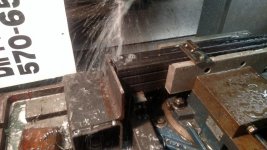I drill 3/8" holes in 1" square tubing, 3/4" from the end and in the middle of the tube. I stack three high, two rows in the vice. Centerdrill the top two tubes to locate the 3/8" drill. After peck drilling, the top two tubes are perfect yet the bottom ones are off slightly. Is there a better drill or way to do this? It's as if the drill bit is walking. We used to do them one at a time in a milling machine manually and this has greatly sped the procedure up but I need to have the holes in the center. They're not off by a lot but enough that bothers me. I've measured the tubes and place them in the vice so that they're all the width but that hasn't helped. Advice?



